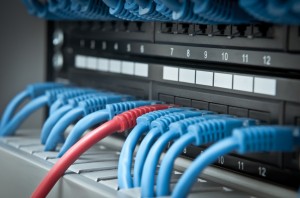Keep Up-to-Date with IP Clocks
The synchronized time keeping industry is ever-evolving, with new technological innovations occurring regularly. If your facility requires a new clock system and already has network infrastructure, why not go with the latest? IP Clocks are the newest in clock system technology. They’re installed, maintained, and provide features to which ordinary wall clocks can’t compare. In addition, they provide features that many wired and wireless clock systems cannot provide. But what is it about these IP clock systems that make them so special, anyway?
How it Works
Unlike wireless clocks, an IP clock system does not require the purchase of a master clock in order for all of the clocks to receive accurate time. Rather, IP Clocks are synchronized via an NTP (Network Time Protocol) server. An NTP server sends the correct time to any device that is connected to pre-existing network infrastructure. Because of this, not only will your clocks be synchronized, but any time-related equipment will also be synchronized, such as time clocks, or the display on your computer screen, to the same time as the clocks. IP Clocks work on the PoE (Power Over Ethernet) protocol. Through PoE protocol, IP clocks receive both power and data through a single cord plugged into either a switch or an injector, eliminating the cost and hassle of multiple wires.
Maintenance
Gone are the days of manual clock adjustment and monitoring. With IP Clocks, the entire system can be supervised through a computer program. Not only that, but some manufacturers offer the option of a web interface which allows for each clock to be viewed individually. By making use of the web interface, any malfunctions or synchronization problems are easily recognized and can be fixed immediately. For easier identification, a name can be given to each clock on the web interface. Similarly, by providing an e-mail address, the software will send notifications regarding malfunctions or synchronization issues so that you do not even have to login to the software.
The Features
As if synchronized time weren’t enough, IP clock systems come with many features that can help contribute to the smooth and efficient operation of any facility. Depending on the manufacturer, digital clocks can perform a variety of functions depending on your preferences. Digital clocks can be set to display in either 12 or 24-hour format and can display alternating date/time. Additionally, they can be set to display text, such as “911” or “FIrE” in an emergency. Dimming modes can also be set for digital displays during certain hours, and in some cases, they can be set to count-up or count-down. Some manufacturers also have the option of automatic Daylight Saving Time and Time Zone adjustment so there will be no confusion in time regardless of the date or country.
Whether it be the ease of installation, the simple and convenient maintenance, or the variety of additional features, IP Clocks are changing the way people view time synchronization systems. Whatever your application, chances are an IP Clock system will have an attribute that can benefit your needs.

